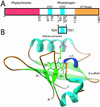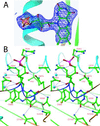Structure of a flavin-binding plant photoreceptor domain: insights into light-mediated signal transduction
- PMID: 11248020
- PMCID: PMC30595
- DOI: 10.1073/pnas.051520298
Structure of a flavin-binding plant photoreceptor domain: insights into light-mediated signal transduction
Abstract
Phototropin, a major blue-light receptor for phototropism in seed plants, exhibits blue-light-dependent autophosphorylation and contains two light, oxygen, or voltage (LOV) domains and a serine/threonine kinase domain. The LOV domains share homology with the PER-ARNT-SIM (PAS) superfamily, a diverse group of sensor proteins. Each LOV domain noncovalently binds a single FMN molecule and exhibits reversible photochemistry in vitro when expressed separately or in tandem. We have determined the crystal structure of the LOV2 domain from the phototropin segment of the chimeric fern photoreceptor phy3 to 2.7-A resolution. The structure constitutes an FMN-binding fold that reveals how the flavin cofactor is embedded in the protein. The single LOV2 cysteine residue is located 4.2 A from flavin atom C(4a), consistent with a model in which absorption of blue light induces formation of a covalent cysteinyl-C(4a) adduct. Residues that interact with FMN in the phototropin segment of the chimeric fern photoreceptor (phy3) LOV2 are conserved in LOV domains from phototropin of other plant species and from three proteins involved in the regulation of circadian rhythms in Arabidopsis and Neurospora. This conservation suggests that these domains exhibit the same overall fold and share a common mechanism for flavin binding and light-induced signaling.
Figures






References
-
- Singhal G S, Renger G, Sopory S K, Irrgang K-D, Govindjee . Concepts in Photobiology: Photosynthesis and Photomorphogenesis. Boston: Kluwer; 1999. pp. 775–929.
-
- Batschauer A. Planta. 1998;206:479–492. - PubMed
-
- Briggs WR, Huala E. Annu Rev Cell Dev Biol. 1999;15:33–62. - PubMed
-
- Fankhauser C, Chory J. Curr Biol. 1999;9:123–126. - PubMed
-
- Cashmore A R, Jarillo J A, Wu Y J, Liu D M. Science. 1999;284:760–765. - PubMed
Publication types
MeSH terms
Substances
Associated data
- Actions
Grants and funding
LinkOut - more resources
Full Text Sources
Other Literature Sources
Miscellaneous

